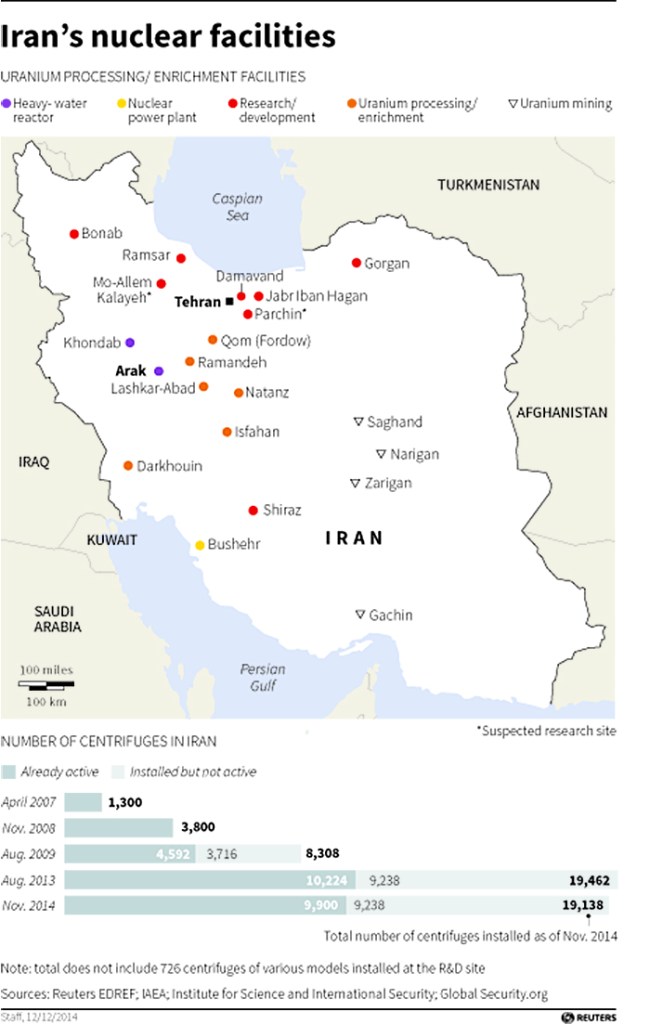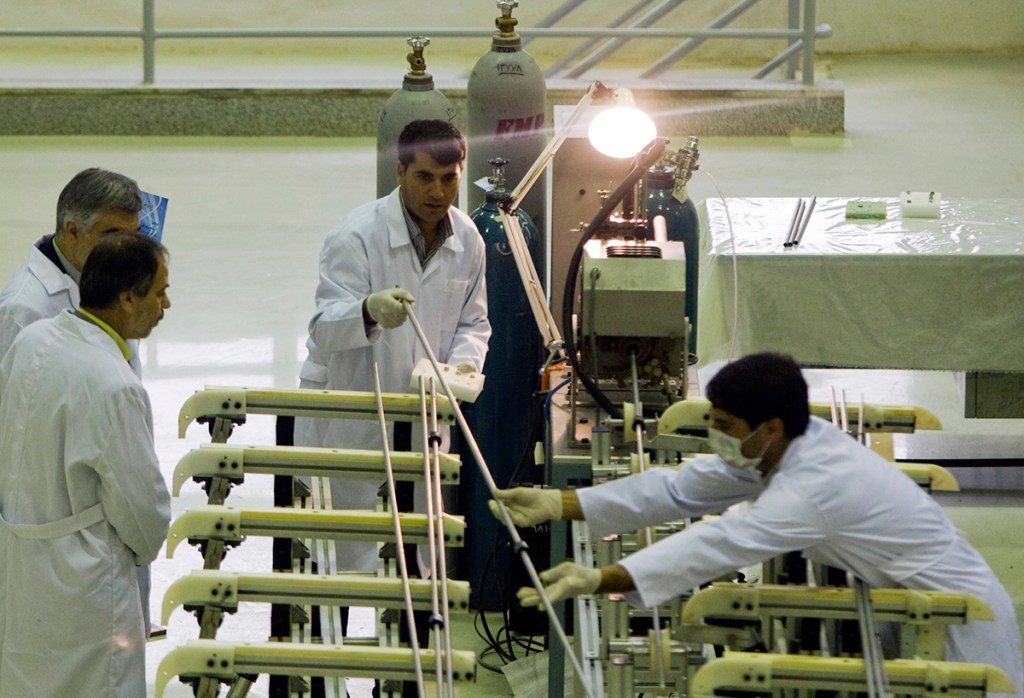WASHINGTON — Beneath the dispute between Israeli Prime Minister Benjamin Netanyahu and President Obama about the risks and benefits of nuclear negotiations with Iran lie a wealth of unresolved and highly technical questions.
Undersecretary of State Wendy Sherman has often compared the talks to a Rubik’s Cube: All the pieces of the puzzle must fit together before it’s solved.
“Nothing is agreed until everything is agreed,” Sherman has repeatedly told reporters.
The goal of the world powers negotiating with Iran is to prevent it from producing enough weapons-grade fuel for a nuclear weapon — and to ensure that Iran would need at least 12 months to do so if it were to break out of international safeguards, up from two to three months now.
While the two sides say progress has been achieved on several issues, here are some of the major gaps that remain between Iran and the “P5-plus-1,” the five permanent members of the United Nations’ Security Council — China, France, Russia, Britain and the United States — and Germany:
URANIUM ENRICHMENT
One of the biggest issues is the extent of Iran’s uranium enrichment capability. That involves determining how many centrifuges are enough to meet Iran’s needs for civilian energy and medical research. Iran now has about 20,000 centrifuges. About 10,200 are operational and enriching uranium at two sites, Natanz and Fordo. The rest are installed but not operating.
“There are different formulas that can be used to reach that outcome, which involve the number of centrifuges, certain types of centrifuges, certain configurations of centrifuges and a certain stockpile of low-enriched uranium,” said Daryl Kimball, executive director of the Arms Control Association, a Washington-based research group. “A 12-month ‘breakout’ window would allow more than enough time to detect and disrupt any potential Iranian dash for nuclear weapons.”
Netanyahu and some members of Congress say Iran shouldn’t be allowed to have any domestic enrichment capacity.
Obama administration officials said last week that zero enrichment is a non-starter because Iran maintains that it has the right to peaceful enrichment under the Nuclear Non- Proliferation Treaty, and the U.S.’s negotiating partners won’t agree to forcing a halt to all enrichment. Such a demand from the U.S. would split the P5+1 coalition and cause the talks to fail, U.S. officials have said.
Iran has said it needs to enrich uranium for its civilian nuclear reactor in Bushehr, although Russia has a contract to provide fuel for it until 2021.
OLDER-MODEL CENTRIFUGES
The United States and its partners have been pushing for a deal that permits Iran to continue using only older-model centrifuges, known as IR-1s, that make up the majority of its inventory. The Obama administration has hailed the interim accord that’s now in effect because Iran agreed that it won’t operate any of its newer centrifuges, which enrich uranium at a faster rate.
In talks last month, negotiators discussed the possibility of Iran keeping 5,000 of its 9,400 operating first-generation centrifuges at Natanz, while the rest would be disabled to make it very difficult to use them again, according to Israeli newspaper Haaretz. The world powers don’t want any centrifuges operating at the underground Fordo facility.
One possibility would be to let Iran gradually increase the number of centrifuges it operates over the years if it sticks with the terms of the agreement, including international inspections. Centrifuges also can be reconfigured to enrich less uranium.
URANIUM STOCKPILE
Under the interim agreement signed in November 2013, Iran agreed to give up its stockpile of medium-enriched uranium, converting it into plates for use in a medical reactor. Negotiators from the six nations also want Iran to dramatically reduce its stockpile of low-enriched uranium, sending most of it to Russia, where it would be converted into nuclear fuel for the Bushehr power reactor.
Under the interim accord, Iran also agreed to allow inspections of its nuclear facilities, giving U.N. inspectors daily access for the first time to enrichment facilities at its Natanz and Fordo plants, a heavy water reactor at Arak that could produce plutonium fuel for weapons, centrifuge assembly facilities and uranium mines and mills.
In any final deal, the U.S. and its partners have insisted that Iran must allow unrestricted access and “intrusive verification.”
MILITARY DIMENSIONS
One point of contention is whether Iran will allow access to military sites, including ones that intelligence agencies have said may contain evidence of past research into developing a nuclear weapon. The U.N.’s International Atomic Energy Agency has raised questions about whether Iran tested explosive components needed for a weapon at its Parchin military base.
Iran has insisted that its program is solely for civilian energy and medical research, and that it’s not interested in a nuclear weapon.
The IAEA is investigating Iran’s past programs. A resolution to the possible military aspect of Iran’s nuclear work is one of the key gaps that must be bridged to reach a final deal, according the terms of the interim accord signed in November 2013. U.N. Security Council resolutions demand that Iran clarify whether any of its activities were intended to build a weapon before sanctions can be lifted.
SANCTIONS’ FATE
Iranian officials have demanded publicly that all sanctions imposed by the U.S., the European Union and the U.N. be removed once a deal is reached. U.S. officials have said they will never agree to this, and that sanctions will be eased on a gradual basis, depending on Iran’s compliance with the terms.
Last week, administration officials said the sanctions architecture would remain in place so that the penalties could “snap back” if Iran violated an accord.
Obama can reverse White House executive orders issued over the years. He also can waive sanctions approved by Congress, including those that limit Iran’s oil exports, but he can’t eliminate them without congressional approval. About 60 percent of sanctions on Iran have been codified in U.S. law, which gives Congress a strong hand, according to Ali Vaez, an Iran specialist at the International Crisis Group.
A number of sanctions were imposed on Iran for human rights violations, ballistic missile work and support for organizations labeled as terrorists such as Hezbollah and Hamas, and none of those would be removed in any nuclear deal, according to administration officials.
“Iran is only going to get sanctions relief if they agree with the P5 proposal to reduce their enrichment capacity for a number of years,” said Kimball of the Arms Control Association. “The agreement is within reach.”
LIMITS’ DURATION
A final key issue to be resolved is the duration of the core limits on Iran’s nuclear program. Iran must accept an agreement lasting at least 10 years, Obama said Monday in an interview with Reuters. Iran has called for a shorter period, and proposals under discussion include allowing it to increase the number of operating centrifuges after as few as six years.
“It appears that the two sides are still sorting out the sequencing of the step-for-step phases of the agreement, which will likely be 10-to-15 years in length, though many elements, including expanded IAEA monitoring would continue indefinitely,” Kimball said.
Copy the Story LinkSend questions/comments to the editors.




Success. Please wait for the page to reload. If the page does not reload within 5 seconds, please refresh the page.
Enter your email and password to access comments.
Hi, to comment on stories you must . This profile is in addition to your subscription and website login.
Already have a commenting profile? .
Invalid username/password.
Please check your email to confirm and complete your registration.
Only subscribers are eligible to post comments. Please subscribe or login first for digital access. Here’s why.
Use the form below to reset your password. When you've submitted your account email, we will send an email with a reset code.